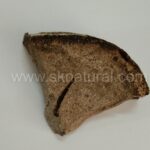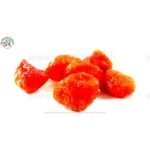Description
Noshadar Thikri at sknatural is the crystallized lumps form of ammonium chloride. It is warm and dry in third degree. Noshadar found as a white encrustation around volcanoes, commonly appears in the market as impure, dirty white, or brownish translucent cakes. As it derives from a type of clay. Additionally, people can obtain it from the combustion of excretions from various animals. Hence, serving as a secondary product in the manufacturing process of coal gas.
In this process, the unburnt ends of brick kilns utilize animal manure, resulting in another source. During this process, they add coal and common salt, then sublimate them, resulting in white granular crystals or transparent masses. It exhibits high solubility in water, displaying deliquescence, a saline taste, and a disagreeable, nauseous, and pungent flavor. To purify it, one can dissolve it in hot water, evaporate it to dryness, and store it in bottles as a powder.
Other names:
- Arabic Name(s): Milh-un-Nar
- Urdu Name(s): Naushadar, Milh-un-Nar, Naushadar Qalmi
- English Name(s): Chloride of Ammonia, Sal Ammonia
Properties:
Alterative, expectorant, cholagogue in small doses, in large doses purgative. Demulcent, resolvent of inflammations, expectorant, stimulant for liver and stomach, absorbent for abnormal quantity of catarrhs, desiccative, detergent, diuretic, antidotary.
Recommended dosage:
Approximately 120 mg. – 1 g
Medicnal uses:
Noshadar thikri stimulates the mucous membranes, increasing their secretion and affecting the absorbent system and gland structures. It relieves hepatic congestion and modifies hepatic secretions. Hence, proving useful in cases of hepatic abscess, chronic hepatic congestion, and dropsy associated with liver and ovarian diseases, as well as in cirrhosis and jaundice caused by excess catarrh of the bile ducts. In cases of hepatitis, a mixture of sal-ammoniac with wormwood, well rubbed in a mortar with a little water provides relief.
Furthermore, in conditions like biliousness due to gastric catarrh, flatulence, and foul breath, it demonstrates beneficial effects. When dealing with bronchial and vesical catarrh, pharyngitis, and whooping cough, it is combined with glycyrrhiza and administered in recommended doses. Additionally, it proves effective in various preparations aimed at menstrual derangements, leucorrhoea, chronic dysentery. Also chronic discharges from the lungs and stomach, neuralgia, intermittent fevers, and affections of glands such as the thyroid and liver, as well as the spleen.
Moreover, it serves as a useful cooling application for the head in conditions like headache, sprains, rheumatism, sciatica, erysipelas, and chronic skin diseases, and as a dressing for bruises and blows on the eyes (black eye), along with local application in cases of cataract. Noshadar thikri also corrects metabolic alkalosis. Its solutions act as local irritants, exerting rubefacient action, while in high concentrations, they function as vesicants. 






Reviews
There are no reviews yet.